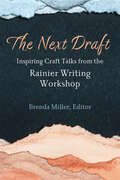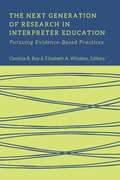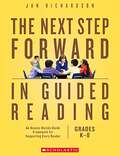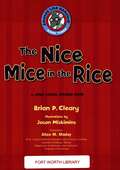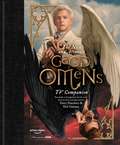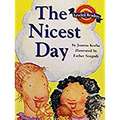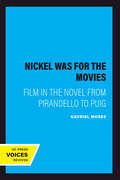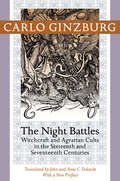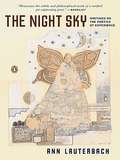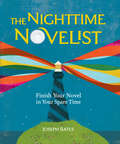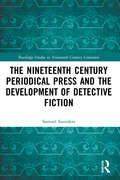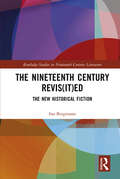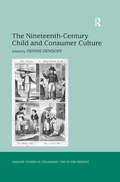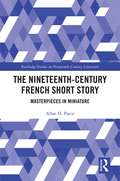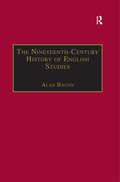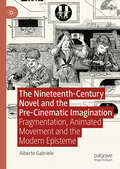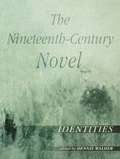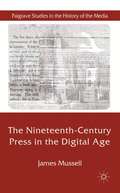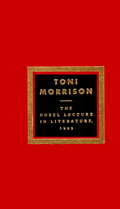- Table View
- List View
The Next Draft: Inspiring Craft Talks from the Rainier Writing Workshop (Writers On Writing)
by Brenda MillerThe Next Draft: Inspiring Craft Talks from the Rainier Writing Workshop brings together a selection of the “morning talks” delivered by the renowned authors who teach at the prestigious Rainier Writing Workshop MFA program. These morning talks are a highlight of the residencies at Pacific Lutheran University in Tacoma, Washington, featuring inspiring, innovative approaches to writing and literature across genres. For this collection, Brenda Miller has selected essays that feature diverse and illustrious writers such as Geffrey Davis, Marjorie Sandor, Barrie Jean Borich, Jenny Johnson, Oliver de la Paz, Lia Purpura, Kent Myers, Rebecca McClanahan, and others. Ranging from reading and writing in the Jewish tradition of midrash to the role of the writer as cultural critic in the 21st century, The Next Draft brings to life the kind of intellectual and creative excitement that underlies the intensive MFA experience at Pacific Lutheran University. Not only do these talks show innovative approaches to writing and literature across genres, they inspire the reader to think about how to read differently and thus bring their own work to a new level.
The Next Generation of Research in Interpreter Education: Pursuing Evidence-Based Practices (The Interpreter Education Series #10)
by Cynthia B. Roy Elizabeth A. WinstonThis collection contributes to an emerging body of research in sign language interpreter education, a field in which research on teaching practices has been rare. The Next Generation of Research in Interpreter Education investigates learning experiences and teaching practices that provide the evidence necessary to inform and advance instructional approaches. The five studies included in this volume examine role-play activities in the classroom, the experiences of Deaf students in interpreting programs, reducing anxiety in the interpreting process, mentoring, and self-assessment. The contributors are a nascent group of educators who represent a growing mastery of contemporary standards in interpreter education. Their chapters share a common theme: the experiences and learning environments of students as they progress toward entry into the interpreting profession.
The Next Step Forward In Guided Reading: An Assess-decide-guide Framework For Supporting Every Reader
by Jan RichardsonIn this resource-rich book, you’ll find: - All the planning and instructional tools you need to teach guided reading well, from pre-A to fluent, organized around Richardson’s proven Assess-Decide-Guide framework. - Prompts, discussion starters, teaching points, word lists, intervention suggestions, and more to support all students, including dual language learners and struggling readers. - 29 comprehension modules that cover essential strategies―monitoring, retelling, inferring, summarizing, and many others. - Plus an online resource bank with dozens of downloadable assessment and record-keeping forms, Richardson’s all-new, stage-specific lesson plan templates. - More than 50 videos showing Jan modeling key parts of guided reading lessons for every stage. Grade: K-8
The Nibelungen Tradition: An Encyclopedia (Reference Library Of The Humanities)
by Francis G. Gentry Winder McConnell Ulrich Muller Werner WunderlichWithin the English-speaking world, no work of the German High Middle Ages is better known than the Nibelungenlied, which has stirred the imagination of artists and readers far beyond its land of origin. Its international influence extends from literature to music, art, film, politics and propaganda, psychology, archeology, and military history.Now
The Nice Mice In The Rice: A Long Vowel Sounds Book (Sounds Like Reading Ser.)
by Brian P. Cleary Jason MiskiminsUsing rhyme, repetition, and illustrations, this book introduces young readers to long vowel sounds.
The Nice and Accurate Good Omens TV Companion
by Matt WhymanThe ultimate TV companion book to Good Omens, a massive new television launch on Amazon Prime Video and the BBC, written and show-run by Neil Gaiman and adapted from the internationally beloved novel by Terry Pratchett and Neil Gaiman. '[It was] absurdly good fun...Terry charged Neil with getting it made, almost as his deathbed wish, so it's a real labour of love' - David TennantIn the beginning there was a book written by Terry Pratchett and Neil Gaiman about the forces of good and evil coming together to prevent the apocalypse, scheduled to happen on a Saturday just after tea. Now, that internationally beloved novel has been transformed into six hour-long episodes of some of the most creative and ambitious television ever made. Written and show-run by Neil Gaiman and directed by Douglas Mackinnon, this BBC Studios creation brings Good Omens spectacularly to life, through a cast that includes David Tennant, Michael Sheen, Jon Hamm, Miranda Richardson, Josie Lawrence, Derek Jacobi, Nick Offerman, Jack Whitehall and Adria Arjona. Keep calm, because The Nice and Accurate Good Omens TV Companion is your ultimate guide to navigating Armageddon. Through character profiles and in-depth interviews with the stars and the crew, stunning behind-the-scenes and stills photography of the cast and locations, and a fascinating insight into costume boards and set designs, you will discover the feats of creativity and mind-boggling techniques that have gone into bringing an angel, a demon, and the Antichrist to the screens of people everywhere. This book will take you inside the world of Heaven and Hell (and Tadfield) and is set to shatter coffee tables around the world.
The Nickel Was for the Movies: Film in the Novel from Pirandello to Puig
by Gavriel MosesThe cinephobic novelist who complains to Fitzgerald's tycoon that he will never get the hang of scriptwriting wouldn't give a nickel for the movies. Yet never before the appearance of film had human perception been engaged in such an all-encompassing way by a single art form. In this ambitious investigation of a little-studied narrative genre, Gavriel Moses defines and explores "the film novel," a literary text in which cinema provides the thematic, formal, psychological, and philosophical center. Through close readings of works by the major representatives of the genre—Pirandello, Nabokov, Isherwood, West, Fitzgerald, Moravia, Percy, Puig—Moses develops a suggestive theory of novels that use literature to investigate the central role that film has acquired in human experience.These novels, because of their fascination with filmmaker and spectator alike, and because they anticipate current views of the questions of cinema, remain a tangible presence within the repertoire of literary modernism. Offering insightful discussions of Laughter in the Dark, Lancelot, Kiss of the Spider Woman, and other film novels, Moses shows the depth of the exchange between literature and cinema and illustrates the extent to which the way we tell stories with words has been affected by the movies. His book will be of wide interest to literary scholars, film historians, and students of cinema and the novel.
The Night Battles: Witchcraft and Agrarian Cults in the Sixteenth and Seventeenth Centuries (Routledge Library Editions: Witchcraft Ser.)
by Carlo GinzburgA remarkable tale of witchcraft, folk culture, and persuasion in early modern Europe.Based on research in the Inquisitorial archives of Northern Italy, The Night Battles recounts the story of a peasant fertility cult centered on the benandanti, literally, "good walkers." These men and women described fighting extraordinary ritual battles against witches and wizards in order to protect their harvests. While their bodies slept, the souls of the benandanti were able to fly into the night sky to engage in epic spiritual combat for the good of the village. Carlo Ginzburg looks at how the Inquisition's officers interpreted these tales to support their world view that the peasants were in fact practicing sorcery. The result of this cultural clash, which lasted for more than a century, was the slow metamorphosis of the benandanti into the Inquisition's mortal enemies—witches.Relying upon this exceptionally well-documented case study, Ginzburg argues that a similar transformation of attitudes—perceiving folk beliefs as diabolical witchcraft—took place all over Europe and spread to the New World. In his new preface, Ginzburg reflects on the interplay of chance and discovery, as well as on the relationship between anomalous cases and historical generalizations.
The Night Sky
by Ann LauterbachA scintillating collection of essays on language from one of literature's most supple minds In The Night Sky, her first work of essays, acclaimed poet Ann Lauterbach writes of the ways in which art and poetry are integral and necessary to human conversation. At the center of the book is a series of seven essays, by turns meditative and polemical, that articulate the interstices between Lauterbach's poetics and her experience. She advocates an active encounter with language, at once imaginative and practical, and argues for the importance of art to the well- being of a democratic society. Lauterbach's "nimble and glittering" (Booklist) writings bring us to a new understanding of the relationship between self-knowledge and cultural meaning, as well as demonstrating the ways in which contemporary philosophy and theory might be integrated with practical knowledge. .
The Night Sky
by Ann LauterbachA scintillating collection of essays on language from one of literature's most supple minds In The Night Sky, her first work of essays, acclaimed poet Ann Lauterbach writes of the ways in which art and poetry are integral and necessary to human conversation. At the center of the book is a series of seven essays, by turns meditative and polemical, that articulate the interstices between Lauterbach's poetics and her experience. She advocates an active encounter with language, at once imaginative and practical, and argues for the importance of art to the well- being of a democratic society. Lauterbach's "nimble and glittering" (Booklist) writings bring us to a new understanding of the relationship between self-knowledge and cultural meaning, as well as demonstrating the ways in which contemporary philosophy and theory might be integrated with practical knowledge.
The Nighttime Novelist: Finish Your Novel in Your Spare Time
by Joseph BatesMake Every Creative Moment Count Franz Kafka was an insurance agent. William Faulkner was a postmaster. Stephen King taught high school English, John Grisham was an attorney, and Toni Morrison worked in publishing. Though romantic fantasies of the writing life don't often include a day job, the fact is that most writers have one. If you find yourself among them, stealing moments late at night, early in the morning, or on your lunch break to write, The Nighttime Novelist is your guide-on call any hour to help. Divided into quick mini lessons to make the most of your precious writing time, this book offers: Technique instruction that breaks down the elements of the novel-from crafting your protagonist to successful plotting and pacing Hurdle lessons that help you anticipate and overcome roadblocks, so you can keep your productivity and your story on track Going Deeper explorations that provide guidance on the more nuanced aspects of storytelling, so you can take your work to the next level Try It Out assignments and more than 25 interactive worksheets that help you apply the lessons to your own project Whether you're just beginning your novel, wondering how to navigate its middle, or bringing it to a close, you'll find the instruction, exercises, and support you need to keep your story moving forward every time you sit down to write.
The Nineteenth Century Periodical Press and the Development of Detective Fiction (Routledge Studies in Nineteenth Century Literature)
by Samuel SaundersThis book re-imagines nineteenth-century detective fiction as a literary genre that was connected to, and nurtured by, contemporary periodical journalism. Whilst ‘detective fiction’ is almost universally-accepted to have originated in the nineteenth century, a variety of widely-accepted scholarly narratives of the genre’s evolution neglect to connect it with the development of a free press. The volume traces how police officers, detectives, criminals, and the criminal justice system were discussed in the pages of a variety of magazines and journals, and argues that this affected how the wider nineteenth-century society perceived organised law enforcement and detection. This, in turn, helped to shape detective fiction into the genre that we recognise today. The book also explores how periodicals and newspapers contained forgotten, non-canonical examples of ‘detective fiction’, and that these texts can help complicate the narrative of the genre’s evolution across the mid- to late nineteenth century.
The Nineteenth Century Revis: The New Historical Fiction (Routledge Studies in Nineteenth Century Literature)
by Ina BergmannThe Nineteenth Century Revis(it)ed: The New Historical Fiction explores the renaissance of the American historical novel at the turn of the twenty-first century. The study examines the revision of nineteenth-century historical events in cultural products against the background of recent theoretical trends in American Studies. It combines insights of literary studies with scholarship on popular culture. The focus of representation lies on the ‘long’ nineteenth century – a period from the early Republic to World War I – as a key epoch of the nation building project of the United States. The study explores the constructedness of historical tradition and the cultural resonance of historical events within the discourse on the contemporary novel and the theory formation surrounding it. At the center of the discussion is the unprecedented literary output and critical as well as popular success of historical fiction in the USA since 1995. An additional postcolonial and transatlantic perspective of the study is provided by the incorporation of texts by British and Australian authors and especially by the inclusion of insights from Neo-Victorian Studies. The book provides a critical comment on current and topical developments in American Literature, Culture, and Historiography.
The Nineteenth-Century Child and Consumer Culture (Studies in Childhood, 1700 to the Present)
by Dennis DenisoffDuring the rise of consumer culture in the nineteenth century, children and childhood were called on to fulfill a range of important roles. In addition to being consumers themselves, the young functioned as both 'goods' to be used and consumed by adults and as proof that middle-class materialist ventures were assisting in the formation of a more ethical society. Children also provided necessary labor and raw material for industry. This diverse collection addresses the roles assigned to children in the context of nineteenth-century consumer culture, at the same time that it remains steadfast in recognizing that the young did not simply exist within adult-articulated cultural contexts but were agents in their formation. Topics include toys and middle-class childhood; boyhood and toy theater; child performers on the Victorian stage; gender, sexuality and consumerism; imperialism in adventure fiction; the idealization of childhood as a form of adult entertainment and self-flattery; the commercialization of orphans; and the economics behind formulations of child poverty. Together, the essays demonstrate the rising investment both children and adults made in commodities as sources of identity and human worth.
The Nineteenth-Century French Short Story: Masterpieces in Miniature (Routledge Studies in Nineteenth Century Literature)
by Allan PascoThe 19th-Century French Short Story, by eminent scholar, Allan H. Pasco, seeks to offer a more comprehensive view of the definition, capabilities, and aims of short stories. The book examines general instances of the genre specifically in 19th-century France by recognizing their cultural context, demonstrating how close analysis of texts effectively communicates their artistry, and arguing for a distinction between middling and great short stories. Where previous studies have examined the writers of short stories individually, The 19th-Century French Short Story takes a broader lens to the subject, and looks at short story writers as they grapple with the artistic, ethical, and social concerns of their day. Making use of French short story masterpieces, with reinforcing comparisons to works from other traditions, this book offers the possibility of a more adequate appreciation of the under-valued short story genre.
The Nineteenth-Century History of English Studies (The Nineteenth Century Series)
by Alan BaconThis study collects together many of the original texts from the long-running debate which surrounded the rise of English as an academic subject. Most of the texts were ephemeral and have been long out of print, but they are essential to an understanding of how English studies developed. They show how English was influenced by pre-existing subjects like rhetoric and classics, and how it assumed different faces in different academic institutions. Each text is given an introduction which sets it in context and highlights themes. A general introduction to the book sketches the history of English studies in the nineteenth century. London was central to the early history, with University College, King’s College and Queen’s College all looming large. Oxford figured later in the century, and became the centre of a truly national debate over the future of the subject. Schools played a part, especially grammar schools catering for middle-class pupils who were commonly identified as the main market for English.
The Nineteenth-Century Novel and the Pre-Cinematic Imagination: Fragmentation, Animated Movement and the Modern Episteme
by Alberto GabrieleThis book fills a gap in existing scholarship on the history of the novel in relation to visual culture by discussing the visual fascination that novelists such as Nathaniel Hawthorne, Herman Melville, Honoré de Balzac and George Eliot show for several types of pre-cinematic spectacle. It also identifies a so far neglected aspect of novel theory that nineteenth-century authors elaborated by incorporating suggestions from pre-cinematic visual spectacles. By shedding light on forms of visuality that were not entertained by the dominant aesthetic modes of painting and photography, The Nineteenth-Century Novel and the Pre-Cinematic Imagination argues that the presence of nineteenth century pre-cinematic optical illusions in works of fiction redefines the notion of mimesis as animated movement and points to a continuity between pre-cinema, the literary imagination and the structures of knowledge production of the modern episteme.
The Nineteenth-Century Novel: Identities (Nineteenth Century Novel Ser.)
by Dennis WalderThe Nineteenth-Century Novel: Identities provides an ideal starting point for understanding gender in the novels of this period. It explores the place of fiction in constructing gender identity within society at large, considering Madame Bovary, Portrait of a Lady and The Woman in White. The book continues with a consideration of the novel at the fin de siecle, examining Dracula, The Awakening and Heart of Darkness. These fascinating essays illuminate the ways in which the conventions of realism were disrupted as much by anxieties surrounding colonialism, decadence, degeneration and the 'New Woman' as by those new ideas about human psychology which heralded the advent of psychoanalysis. The concepts which are crucial to the understanding of the literature and society of the nineteenth century are brilliantly explained and discussed in this essential volume.
The Nineteenth-Century Press in the Digital Age
by James MussellNewspapers and periodicals have long been recognized as indispensable resources for those interested in all aspects of the nineteenth century, but they remain neglected due to difficulties working with the large and complicated print archive. In The Nineteenth-Century Press in the Digital Age, Mussell provides an accessible account of how this archive has been transformed through digitization. Now that it is relatively accessible, he argues that we cannot afford to continue to ignore this material. However, we must be able to understand both the complicated forms of newspapers and periodicals and how they have been transformed by various digital resources. In this book, Mussell situates both the print and the digital within a broader media history and argues that the way to understand a culture is through its media, whether this is in the nineteenth century, or today.
The No-Nonsense Guide to Global Media
by Peter StevenPeter Steven explores the diversity of world media, from the corporate to the independent. He introduces readers to the political economy of the major media outlets, looking at the concentration of ownership and the convergence of technologies and media functions. In doing so, he encourages us to question how the media reflects society: are we passive recipients, or do we have a part in constructing the world?Peter Steven is a freelance writer based in Toronto, Canada. He has been a film columnist for New Internationalist and The Beaver magazines, and associate editor of Jump Cut magazine.
The Nobel Lecture In Literature, 1993
by Toni MorrisonToni Morrison, winner of the 1993 Nobel Prize in Literature, reads the speech she delivered in Stockholm, Sweden, at the Nobel Prize Award Ceremony.
The Noisy Book Starring Yakety Yak
by Edith AdamsYakety Yak can't stop making noise until one day his neighbor's notice a difference. Is Yak trying to please his neighbors? Or...
